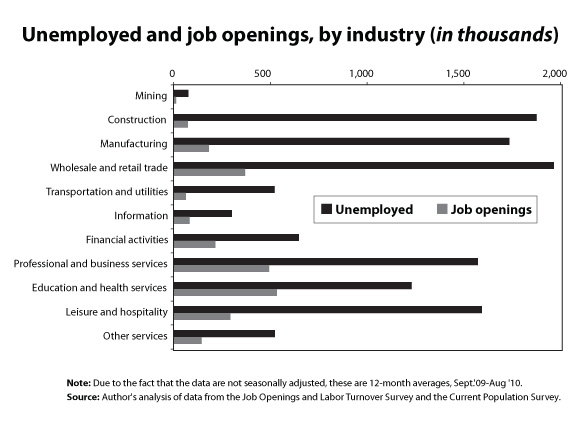This morning the Bureau of Labor Statistics released the August report from the Job Openings and Labor Turnover Survey (JOLTS), showing that job openings increased by 60,000 in August (and upward revisions to earlier data reveal that there were 99,000 more jobs openings in July than previously reported).
The total number of job openings in August was 3.2 million. From the August Current Population Survey, we know that the total number of unemployed workers was 14.9 million. This means that the ratio of unemployed workers to job openings was 4.6-to-1 in August, unchanged from the revised July ratio. It is important to note that this ratio does not measure the number of applicants for each job. There may be throngs of applicants for every job posting, since job seekers apply for multiple jobs. The 4.6-to-1 ratio means that for every 46 unemployed workers, there are only 10 available job openings.

No evidence that unemployment is predominantly structural
If, as some have claimed, unemployment right now is predominantly structural, (meaning that unemployment is high primarily because today’s unemployed workers are not well-suited for the jobs becoming available), then we would expect to find some sectors where there are more unemployed workers than job openings, and some sectors where there are more job openings than unemployed workers. In other words, for structural unemployment to be a major part of overall unemployment, there would have to be significant labor shortages in some areas, as employers with job openings couldn’t find suitable workers. But there are no major sectors where that is happening—the lack of job openings is occurring across the board. Figure 2 shows job openings and unemployment by sector and shows that unemployed workers dramatically outnumber job openings in every sector. In other words, the economy isn’t lacking the right workers, it is simply lacking jobs. The lack of evidence behind the structural unemployment argument is detailed in the recent EPI report, Reasons for Skepticism About Structural Unemployment.

Looking again at the August job-seekers to job-openings ratio of 4.6-to-1, it’s important to note the good news that the ratio is significantly improved from its peak last November of 6.2-to-1. However, there remains a severe lack of jobs. The ratio of unemployed workers per job opening is still much higher than at the worst point in the early 2000s recession, which was 2.8 unemployed workers per job opening in September 2003. In the first half of 2007, before the downturn began, the ratio averaged 1.5-to-1. August’s ratio, at 4.6-to-1, was over three times that high.
With so many unemployed workers per available job, it is no surprise that workers who have gotten laid off continue to get stuck in unemployment for very long periods. In August, 42.0% of this country’s unemployed workers had been unemployed for over six months.
Furthermore, when calculating the ratio of job seekers to job openings, if we were to include not just the 14.9 million unemployed workers, but also the 8.9 million “involuntarily part-time” workers (part-time workers who want and are available for a full-time job, and are therefore likely job searching), the ratio would be 7.4-to-one.
In August there were 11.7 million more unemployed workers than there were job openings. Tomorrow the Bureau of Labor Statistics will release the September employment and unemployment numbers. The expectation is for weak employment growth in September, and a slight increase in the unemployment rate. The Congressional Budget Office estimates that without the American Recovery and Reinvestment Act (ARRA) of 2009, the unemployment rate would be up to 2 percentage points higher than it is right now. In other words, ARRA worked, but was never big enough given the scale of the crisis. It is time for Congress to do more to create jobs.
—Research assistance provided by Andrew Green
